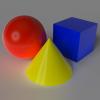-
Posts
144 -
Joined
-
Last visited
whodini's Achievements
-
I have primitive groups set up in SOP level, something simple like a box with a voronoi fracture applied with the inside and outside primitive groups. How can I access this primitive group in shop context? I am trying to compare whether or not a shading point belongs to a specified group so I can create a mask. I can create a attribute at sop level to store the group information on the points and that works, but I want to do this in the shop context because the geometry will be heavily subdivided and displaced and I need the accuracy. Any thoughts?
-
I got this partially working, or at least it looks like it's working at SOP level, however I cant seem to get this to render with the shader. I keep getting a black output render. I fixed all the errors I got in houdini 14, it was mainly complaining about the surface model. Any ideas how this might be able to work in H14
-
I'm noticing one more thing, if I set the particle separation and collision separation to low values like 0.025 with a more complex collider with curved sides I notice that the liquid loses a lot of volume almost as if it compressed or flattened.
-
Sweet! I was also working on a deadline submit tool a while back. I ended up writing custom python scripts that would parse the hip file and render through hython. I'll take a look at your asset soon.
-
Thanks Igor, I'm looking at the results now. This works!! The tetrahedralize sop and the scatter density on the points from volume helped A LOT!! I'll give this a shot a more complex scene. Thank you for all your help!
-
I'm also noticing that if the collider object is animated the flip simulation has jittering issues because the collision field for the collider object is different every frame. Is there a good solution to this issue?
-
Hey guys I've been exploring hython in-depth and I'm wondering if there is a way to capture the render statistics of a file and write it to a file. At the moment my only solution is running something like: hython myscript.py > mylog.txt However, I want to write the file from within the script and not redirect the output of the command from the shell. In my script I'm just doing something like this: import hou rop = hou.node("/out/mantra1") rop.render() # I need the output of this function Any help appreciated thank you guys!
-
Igor's method works really well in my situation. I just added a VDB reshape SDF set to dilate on the B side of the combine VDB sop. And slowly increase the dilate value by small increments until all the gaps in the fluid are completely gone and it sits perfectly flat on the container. The reasons there is such a large gap between my fluid sim and the container is because I had to use a little but of offset on the collision geo in DOPS. Not sure how to get around that issue post sim.
-
I'd go with Centos, just because its maintained and updated by the group who brought us RedHat, in fact is almost identical to redhat without the branding and logos of course. And a lot of big software developers work and test natively and build on Centos.
-
Ok I ended up narrowing this down. It's my houdini build. I'm on 13.0.509. I rolled back to 13.0.484 and used the standard fluid source node to create collision and collisionvel fields and the collisions are clean and dont have the flicker or jitter issue. Actually this issue stills seems present in even the current stable production build. It looks like the velocity field is spiking because the collision field is different every frame. Here's what I tried, but none are working: - I've added timeblend sops after each collision volume source but still get the nasty jittering around the bottom and sides of the container. - I've checked the collision guide in the flip object and the collisions are represented very clean and accurately but there is a still jitter - Looked through the velocity guide and I see mostly directional vectors but some areas have lots of mangled lines where the jitter happens. - Tried different collision methods: particles / collision volumes but jitter still occurs
-
I'm looking for a good solution to ray particles or gradually snap particles close to a piece of geometry. Lets say I have a liquid pouring shot and I want the liquid mesh to sit perfectly flat on the glass for proper refraction during rendering. I've dug through the foroms here and the sesi forums and I've tried the vdb clipping options but it's not quite the effect I'm going for the result isn't clean enough. Plus I have to use some kind of padding on my collision objects in the flip sim, so there is a gap between the liquid and the glass container its in. Any possible ideas? I've tried some point cloud stuff in vops to get the distance from the liquid particles and the mesh and group particle at a certain distance from the container but how do I smoothly or gradually shit them to the container. I dont want to snap to the container on one move, I want the particles to gradually pull toward the container.
-
Here is a hip file. I made something basic. I'm not sure why my vdb collision object is behaving like this. Play through the sim and look at the base of the container the particles jitter around as the collision volume moves. The vdb collider should have enough resolution I have also doubled the res of it just to troubleshoot. I even tried switching from VDB to source volume for generating collision volume and vel fields and the issue still exists. flip_collision_issue.hip flip_collision_issue_sourcevol.hip
-
I have flip liquid particles in a complex tank or container that has an animated base. The base deforms and the liquid flows and drops around as a result but there are some weird jitter issues with the particles when the collider moves. I notice the issue after meshing or looking through the surface field as an isosurface. I made the container watertight and thick enough to play nice with flip, its a vdb volume called collision and I also trailed it and added collisionvel wand proper vector split to make it work in dops with the source volume node. Is there a way to reduce the particle flickering on animated colliders? The collider ins't moving too fast maybe dropping 1 unit over 30- 40 frames.
-
I was able to get a camera baked out by creating a new camera (with matched parameters) and using origin("","/obj/originalcam","TX") to get the worldspace transform for my original cam (just substitute TX with TY, TZ, RX, RY, RZ) to get the correct component. Then I scoped the transform and rotate channels in the channel and selected the frame range I wanted to export in the dopesheet and chose Edit>Key Selection. Then lastly I chose Channels>Export Displayed Channels as.. and saved the animation range out to a chn file. I saved a hip file with the copied camera, and read the transfroms from the chn file in chops to hook it all up. Note, you may have to parse the chn file to make the baked out data linear if you run into errors, can be done with any text editor. I wish there was an easier way but this method had been my only brute force option.
-
OpenCL support is a great feature but don't kill yourself over it. open cl does speed up the sim by 25 - 35% but I haven't been able to use it in all situations and here's why. First off, open cl simulations on the graphics card will limit you to the number of ram you have on the gpu itself, so if you only have 3gb of ram on your gpu 3gb is all you can use even if your machine has 128gb of system ram. You can also have your motherboard share ram with the gpu but this creates an I/O bottleneck. Additionally you would need to use dedicated and powerful gpu's with lots of cores and lots of ram to even notice a performance boost compared to pure cpu processing.





